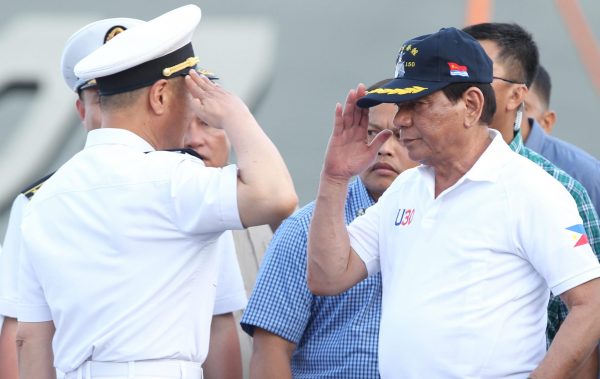Now President Rodrigo Duterte is unravelling his predecessor’s work.
The EDCA was forged to constrain China strategically as it stepped up its expansionist activities in the South China Sea. But Duterte’s goals are diametrically opposed to Aquino’s — Duterte seeks to foster closer economic and diplomatic relations with China while strategically distancing the Philippines from its formal US treaty ally.
After less than three months in office and following the Permanent Court of Arbitration’s landmark ruling favouring Manila’s claims against Beijing in the South China Sea, Duterte launched a diplomatic initiative to earn Chinese goodwill. At the September 2016 ASEAN summit meeting in Laos, he downplayed the maritime dispute and shortly after announced that the Philippine Navy would no longer join US Navy patrols in the disputed waters. He also called for the withdrawal of US forces supporting the Philippine Army’s counter-terrorism missions in Mindanao. At the same time, Duterte sought weapons and soft loans for railroads in Mindanao from Beijing.
In late 2016, the Duterte administration took measures to accommodate Beijing’s security interests at the expense of Manila’s security cooperation with Washington. In December 2016, Philippine Defence Secretary Delfin Lorenzana announced that it was unlikely that Manila would allow the US military to continue using the Philippines as a base for its freedom of navigation patrols in the South China Sea. Duterte also announced he would not protest when it was reported that China was installing weapons on disputed islands deep inside the Philippines’ exclusive economic zone.
Meanwhile, former Philippine foreign secretary Perfecto Yasay Jr admitted that Manila was helpless to stop China’s militarisation of the islands and later remarked that it would be beneficial for the Philippines and the United States to reassess their relationship in light of current geopolitical realities. Clearly, he was referring to President Duterte’s earlier statement that ‘China now is the power [in East Asia], and they [the Chinese] have military superiority in the region’. Parroting China’s rhetoric on the South China Sea dispute, he argued that ‘the present circumstances, such as the South China Sea, may no longer require a strategy based on the old concept of the Cold War’.
Confronted by the Phillipine defence department’s and the armed forces’ resistance to his policy of downgrading the US alliance, Duterte opted to continue joint Philippine–US military exercises. But Duterte said his administration would use EDCA to address non-traditional security concerns like rapid response to natural calamities, while ‘joint military exercises will not be given focus or just downgraded, at least’.
The President’s objective of appeasing China at the expense of the Philippine–US alliance was evident during the annual joint US–Philippine Balikatan military exercise in 2017. Unlike previous Balikatan that involved massive combat drills directed at a hypothetical threat emanating from the South China Sea, this year’s exercises focused on humanitarian, cybersecurity and counter-terrorism exercises. The usually visible live-fire components were removed, while the number of Philippine and US forces involved was scaled down from 11,000 in 2016 to 5400 in 2017.
Duterte’s focus on non-traditional security has essentially rendered the alliance useless in constraining and deterring Chinese maritime expansion into the South China Sea. To make matters worse, in early 2017, Duterte warned the United States that he would unilaterally terminate the EDCA in response to reports that US forces were building permanent arms depots in violation of the agreement and the Philippine constitution. Defence Secretary Lorenzana warned that unless the United States guaranteed to support its ally in any potential future confrontation, the Philippines would consider scrapping the agreement to avoid being entangled in any conflict in the South China Sea.
These developments indicate that the Duterte Administration is gravitating from a tactical to an outright or strategic appeasement of China. Duterte is determined to take advantage of China’s emergence as a major economic power in East Asia and, in the process, replace Philippine–US security relations with Philippine–China economic ties as the country’s most important bilateral relationship.
Like some other East Asian countries — Cambodia, Laos and Myanmar among them — Duterte believes that the Philippines does not have the capabilities to challenge China in the South China Sea dispute. He has also spoken more critically about the United States, doubting Washington’s willingness to back the Philippines militarily in any future confrontation with China. For him, the only option is to foster economic interdependence with China to reduce the likelihood of armed confrontation.
All this generates major stress in the Philippine–US security relationship, and that stress has potential to unravel the alliance in the near future. Duterte’s China strategy might convince other Southeast Asian claimant states to negotiate directly with China to manage or eventually resolve territorial rows. Washington’s status and influence is waning in maritime Southeast Asia.
Renato Cruz De Castro is professor in the International Studies Department, De La Salle University, Manila and holds the Charles Lui Chi Keung Professorial Chair in China Studies.
This article appeared in the most recent edition of East Asia Forum Quarterly, ‘China’s Influence’.


FIRST, Burma, then Nepal, now the Philippines. Each removes a brick in the wall against Chinese dominance and aggression in the South China Sea area.
First, I think money handed in bundles to ‘Leaders’ of nations buys huge movements towards China.
Second, best be careful of who a nation will slander and who it will embrace. The constant attacks on our President, does not inspire any American to care much if China tries to ‘run over’ a SCS nation.
In other words, be careful of what one wishes for: you may sadly get that wish. We still believe in the quote from a Texas cowboy: “I’m going to dance with the one that done brought me.” Sound advice.
Good luck…..